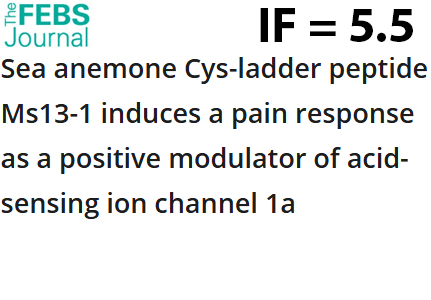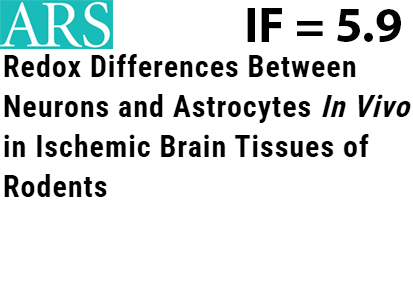Press-room / Digest

FEBS Journal Editor’s choice: the research article about peptide modulator of ASIC1a with a unique structure
Researchers from Laboratory of Neuroreceptors and Neuroregulators and Laboratory of Biomolecular NMR-Spectroscopy of IBCh RAS, together with the Laboratory of Biological Testing of the BIBCh, isolated and characterized Ms13-1, a new peptide of the sea anemone Metridium senile with a unique 3D-structure and a pronounced selective effect on acid-sensing ion channels ASIC1a. Ms13-1 has a spatial fold named the "Cys-ladder" by the authors, and is a member of a novel structural class. In the nanomolar range, Ms 13-1 acts as a positive allosteric modulator of ASIC1a, and the injection of the peptide into the mouse hind paw causes pain, which is suppressed by the selective antagonist of ASIC1. The work was published in the FEBS Journal and was marked as the Editors' choice for the May issue. Learn more

Redox differences between neurons and astrocytes in vivo in ischemic brain tissues of rodents
Combinations of novel in vivo approaches allow to detail redox events with high spatiotemporal resolution in the brain tissues of laboratory animals. We demonstrated redox differences between neurons and astrocytes in damaged brain areas of rodents in vivo during ischemic stroke in model of middle cerebral artery occlusion in rats and photothrombosis model in mice. Using highly sensitive genetically encoded biosensor HyPer7 and a fiber-optic neurointerface technology, we demonstrated that astrocytes differ from neurons in elevated hydrogen peroxide levels in the ischemic brain area of rats. Raman microspectroscopy also revealed the overloading of the mitochondrial electron transport chain precisely in astrocytes in the brain tissues of awake mice during acute ischemia.

Autophagy activator with AMPK-mediated mechanism of action
Age-related imbalance between synthesis and degradation of biomolecules in cells leads to the development of, among other, neurodegenerative diseases and diabetes. A decrease in autophagy, a process that is involved in degradation of damaged or dysfunctional cellular components, may contribute to this imbalance. Autophagy is regulated within cells through multiple signaling pathways, including the AMPK (AMP-activated protein kinase)-dependent pathway, which functions as a key sensor of changes in the cell's energy status. Researchers from the IBCh RAS, the A.N. Belozersky Institute of Physicochemical Biology of Moscow State University, the Patrice Lumumba Peoples' Friendship University of Russia, and other institutes assessed the ability of phenoxazine derivatives to activate this process. The lead compound demonstrated specific activation via the AMPK-dependent pathway and low cytotoxicity in three non-cancer cell lines. The work was published in Bioorganic Chemistry.

Plasma protein corona of liposomes loaded with a phospholipid–allocolchicinoid conjugate enhances their anti-inflammatory potential
The staff of the Laboratory of Lipid Chemistry IBCh RAS, together with colleagues from Nizhny Novgorod State University and the Human Proteome Center of the Institute of Biomedical Chemistry, studied the effects of protein coronas formed in human blood plasma ex vivo on different liposomes carrying a colchicine analog. Today colchicine is considered as a possible treatment for cardiovascular complications. On a model of monocytes from human peripheral blood, the protein coronas have been shown to enhance the anti-inflammatory potential of liposomes. A particularly sharp effect was observed for liposomes bearing specific proteins, including minor ones in normal plasma. The results are published in Colloids and Surfaces B: Biointerfaces. Learn more

TLR2 and Zinc: A Surprising Partnership in Immune Signaling
A team of scientists from the Laboratory of Biomolecular NMR Spectroscopy at the Institute of Bioorganic Chemistry of the Russian Academy of Sciences, in collaboration with researchers from China, has made a breakthrough in understanding the function of Toll-like receptor 2 (TLR2), a key component of the innate immune system. Their study, published in FEBS Letters, reveals that TLR2 exhibits a previously unknown ability to bind zinc ions with high affinity and specificity. Toll-like receptors (TLRs) serve as the first line of defense in the immune system by recognizing pathogens and initiating immune responses. Despite extensive research, the precise molecular mechanisms governing TLR activation remain elusive. The newly identified zinc-binding capability of TLR2 provides fresh insights into its regulatory mechanisms. The researchers also identified specific amino acids essential for zinc coordination and TLR2 function, highlighting a potential link between zinc homeostasis and immune activation. These findings suggest that zinc plays a critical role in modulating TLR-mediated immune signaling, opening new avenues for research into immune system regulation and potential therapeutic applications. Learn more

